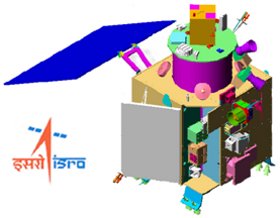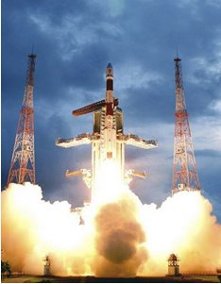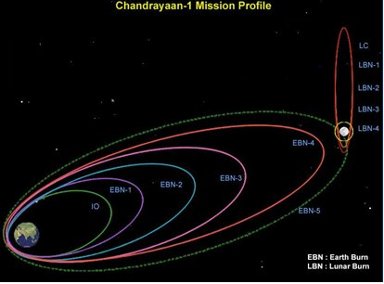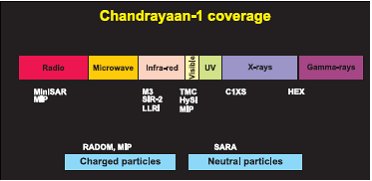
Chandrayaan-1
India’s first scientific mission to Moon
Spacecraft
| Physical |
1.5 m cuboid-shapped main body with a mass of about 600 kg in 100 km lunar orbit |
| Control |
3-axis stabilized using reaction wheels and attitude control thrusters; sun sensors, star sensors, and miniaturized DTGs for orientation reference |
| Power |
Single sided solar array to generate 700 W, 36 Ah Li-Ion Battery for eclipse operations |
| Propulsion |
Bi-propellant system for transferring from initial(Earth) Orbit to Lunar Orbit and orientation maintenance |
| Communication |
TTC in S-band and scientific payload data transmission in X-band |
![[Top]](/images/icons/top.gif)
The Launch
Chandrayaan-1 was carried by Polar Satellite Launch Vehicle (PSLV-C11) from the second launch pad at Satish Dhawan Space Centre (SHAR), Sriharikota. Sriharikota is located in Andhrapardesh, the centre is 80 km north of Chennai in South India. The space craft was first placed into 250 km x 23000 km initial (Earth) orbit. Multiple perigee maneuvers carried out to achieve 380,000 km apogee [Lunar Transfer Trajectory (LTT)] in 17 days in Earth Bound Orbits prior to Lunar encounter. The space craft was successfully inserted into 100 km circular polar lunar orbit on 8 November 2008.
The Mission was declared over on 29 August 2009 after it stopped sending radio signals.

|

|
|
Lift-off of PSLV-C11 carrying Chandrayaan-1
|
Chandrayaan-1 mission profile
|
![[Top]](/images/icons/top.gif)
Scientific objectives
The Chandrayaan-1 mission was aimed at high-resolution remote sensing of the Moon in visible, near Infrared, low energy X-ray and high-energy X-ray regions. Specifically, the objectives are:
-
To prepare a three-dimensional atlas (with a high spatial and altitude resolution of 5-10 m) of both near and far side of the Moon.
-
To conduct chemical and mineralogical mapping of the entire lunar surface for distribution of mineral and chemical elements such as Magnesium, Aluminum, Silicon, Calcium, Iron and Titanium as well as high atomic number elements such as Radon, Uranium and Thorium with high spatial resolution.
The simultaneous photo-geological, mineralogical and chemical mapping through Chandrayaan-1 mission will enable identification of different geological units to infer the early evolutionary history of the Moon. The chemical mapping will enable to determine the stratigraphy and nature of the Moon’s crust and thereby test certain aspects of magma ocean hypothesis. This may allow to determine the compositions of impactors that bombarded the Moon during its early evolution, which is also relevant to the formation of the Earth.
![[Top]](/images/icons/top.gif)
The payloads
Chandrayaan-1 had ten scientific payloads and an impact probe onboard.
Below is the summary of the prime objectives of the eleven payloads carried onboard Chandrayaan-1 mission.
| Prime Objectives |
Payload |
| Chemical Mapping |
Chandrayaan-1 Imaging X-ray Spectrometer (C1XS) High Energy X-ray Spectrometer (HEX) |
| Mineralogical Mapping |
Hyper Spectral Imager (HySI) , Spectrometer InfraRed-2 (SIR-2) , Moon Mineralogy Mapper (M3) |
| Topography Mapping |
LLRI (Lunar Laser Ranging Instrument),TMC (Terrain Mapping Camera) |
| Radiation Environment |
Radiation Dose Monitor (RADOM), HEX, C1XS |
| Magnetic Field Mapping |
Sub KeV Atom Reflecting Analyser (SARA) |
| Volatile Transport |
HEX |
| Radio Mapping |
Miniature Synthetic Aperture Radar (Mini-SAR) |
| Lunar Atmospheric constituent |
MIP (Moon Impact Probe) |

|
|
Summary of Chandrayaan-1 Prime Science Objectives and Wavelength Range Coverage
|
![[Top]](/images/icons/top.gif)
MPS contribution
 SIR-2
SIR-2
![[Top]](/images/icons/top.gif)
